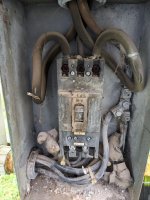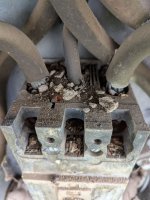xguard
Senior Member
- Location
- Baton Rouge, LA
Working at one of our facilities that was built in the 1960's. The photos are of the service disconnect, unit mounted 225 amp breaker located outdoors. System voltage is 240/120 three phase.
Just curious what you would do if asked to re-use this breaker, i.e. replace the feeder. I typically call to replace equipment in this condition when our project is required to tie into it, maybe I'm being too conservative. This is because I've heard of some of our old breakers cracking when trying to break the lugs loose and also I've assumed the wire insulation may fail if it's disturbed. What has been your experience in these situations?
I've noticed that electrical equipment installed indoors, especially in conditioned spaces, seems to last much longer. Living in Louisiana with the head, humidity and bugs really takes a toll on everything.
A couple notes:
They used 3/0 for some reason when they spliced in a manual transfer switch.
Noticed one phase conductor is smaller than the other two, assuming the high leg but I didn't check the voltage.
Just curious what you would do if asked to re-use this breaker, i.e. replace the feeder. I typically call to replace equipment in this condition when our project is required to tie into it, maybe I'm being too conservative. This is because I've heard of some of our old breakers cracking when trying to break the lugs loose and also I've assumed the wire insulation may fail if it's disturbed. What has been your experience in these situations?
I've noticed that electrical equipment installed indoors, especially in conditioned spaces, seems to last much longer. Living in Louisiana with the head, humidity and bugs really takes a toll on everything.
A couple notes:
They used 3/0 for some reason when they spliced in a manual transfer switch.
Noticed one phase conductor is smaller than the other two, assuming the high leg but I didn't check the voltage.


